During the depths of the Great Depression, a 17-year-old boy from Warren, R.I., enlisted in the Civilian Conservation Corps.
He did it to help support his family, but his time in the Civilian Conservation Corps turned into the adventure of a lifetime.
The CCC started when President Franklin D. Roosevelt persuaded Congress to pass the Emergency Conservation Act on March 31, 1933. His goal: to generate jobs for young men suffering from an almost 25 percent unemployment rate.
The Warren boy at first was too young to join the Civilian Conservation Corps. You had to be 18 to enlist. But in October 1935, the government lowered the age requirement to 17, and he signed up. The teenager met all the other requirements. He was unemployed, unmarried, physically fit and his family was on relief — like tens of millions of other American families.
He earned $30 per month {about $570 today), but he had to send $25 home. That beat the $21 per month that regular U. S. Army soldiers made at the time. The money the CCC boys sent home supported an estimated 12 to 15 million family members.
Go West, Young Men
The Warren boy was sent to Fort Adams in Newport for physical conditioning and evaluation, just as all other enrollees in the nation did at their local Army depot. At the end of their two weeks of training and evaluation, he received his final physical and inoculations. For some of the boys it was the first time they saw a doctor.
The Civilian Conservation Corps assigned the Warren boy to the 141st company posted at Burlingame in Charlestown, R.I. He was issued a blue denim work suit and a renovated Army olive drab uniform with CCC patches. (Roosevelt thought the uniforms looked shoddy and in 1938 ordered the Navy to design a spruce-green uniform.)Then he took the CCC oath.
His company, like several others, was transferred out West, which had more forest work and fewer unemployed young men than in the East. He had to get his parents’ permission because of his age.
He took a train cross country from Fort Adams to a campsite at Triangle Lake near the Town of Junction City, Ore. There they became the 2108 Company of the Civilian Conservation Corps.
In Oregon, the teenager and his company built fire guard service stations, fire lookout towers, trails and shelters. They fought forest fires when needed, a hallmark of the CCC wherever they were.
Cowboys and Mountain Lions
The young man earned a truck driving license issued by the Department of the Interior. He learned to operate a bulldozer, tractor and a jackhammer. He also learned welding, a skill he would later use in helping to build the USS Massachusetts at the Fore River Shipyard in Quincy, Mass.
In Oregon, he served a maximum of four six-month enlistments, all that the CCC allowed and was honorably discharged on June 23, 1936.
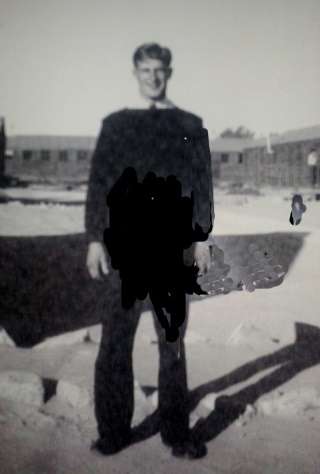
Leo Caisse
He returned to Warren, but after a little more than a year he re-enlisted in 1937. This time was assigned to the 2130th company in Casper, Wyo.
In Wyoming, his Civilian Conservation Corps company built bridges, roads and a dike, according to National Archives records. He fought fires, of course, and some members of his company fought coal fires. While in Wyoming, he also learned another skill: how to evade a mountain lion in the wild.
Later in the 1950s he told stories to his son about how he knew real cowboys and Indians out West. That was really intriguing because it was the heyday of cowboy shows on TV and Cowboy Town in Plainville, Mass. His name was Leo Caisse. He was my father and he passed away when I was very young.
It has been a revelation researching his adventures and it has given me a sense of pride that he and so many others benefitted from this program, which began the green movement.
Roosevelt’s Tree Army
Roosevelt’s Tree Army developed many public parks that still stand today as a living legacy to their work.
Less obvious today was the improved health and well-being of the boys who joined.
Enlistees were so undernourished due to the Depression that they gained an average of 12 pounds each. When issued their uniforms, it was the first time most of them got new shoes.
Many camps had two movies a week with state-of-the-art equipment, chaplain services, lending libraries, organized sports and vocational education. President Roosevelt mandated that all enrollees learn to read and write in the service if they hadn’t achieved literacy yet.
The Civilian Conservation Corps offered 603 different courses nationwide. They often had camp newspapers, wrote poetry, composed songs and put on plays, as well as engaged in organized sports with other camps and local teams.
The men celebrated holidays in camp, including Mother’s Day. In one instance, they invited their mothers to camp for a dinner and the boys put on a skit for them. In another, the commanding officer collected 25 cents from each man to send home a special pillow to their mothers.
The Army ran the CCC, but the state or national park service would select the projects. Since fascism was on the rise overseas, the Army was careful not to drill the Tree Army. Nor did it allow saluting or weapons training.
Still, many Civilian Conservation Corpsmen who joined the Army were automatically inducted as corporals or sergeants, depending on their leadership experience in the Corps.
Following are summaries of the Civilian Conservation Corps in each New England state.
Rhode Island
Rhode Island had eight camps, but they did not all operate continuously or simultaneously. Fort Adams served as their state headquarters.
In the very beginning at least two Rhode Island companies were sent to other states: one to Rangeley, Maine and another company (about 200 men) to Vermont. Later they went to Oregon and Wyoming.
Rhode Island eventually enrolled 15,900 men out of 2.5 million men who served nationally.
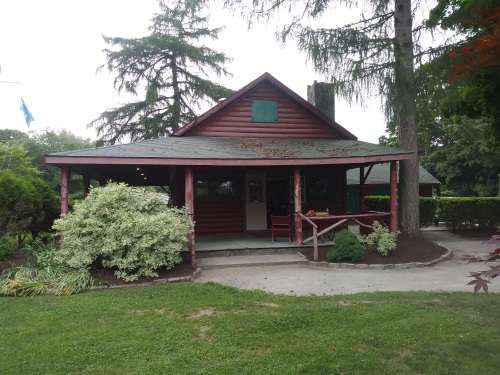
The Civilian Conservation Corps built this structure and many fireplaces at Goddard State Park in Rhode Island.
Massachusetts
Over 100,000 men served in the Massachusetts Civilian Conservation Corps, which brought together two wasted resources: young men and the land.
When the CCC began, Massachusetts had accumulated 100,000 acres, mostly inaccessible to the public. When the Emergency Conservation Act passed, Chief Forester Harold Cook immediately prepared applications for seven camps. He would eventually have 31 camps.
The first enrollees arrived at Fort Devens for medical exams and some basic training and testing to acclimate them to a military routine.
They built roads and trails, overlooks, picnic shelters and log cabins. And they engaged in timber improvement, pest control and forest fire fighting. In the end they planted 12 million trees and improved 170,000 acres of state land. The Massachusetts enrollees collectively sent an estimated $20 million home to their families.
Friends of the Upton State Forest are restoring a former CCC administration building and cottage. At least one former member – and probably many others — was so desperate for work he forged his birth certificate and joined at age 15. He learned construction skills that served him the rest of his working life.
They built the access road to the top of Mount Greylock as well as the Thunderbolt Trail. The CCC created the Savoy State Park, too, and the Elliot Tower in Milton’s Blue Hills Reservation. It still stands today and offers a panoramic view from Boston Harbor to Mount Wachusett. The Blue Hills reception center has a small CCC exhibit that includes memorabilia.
New Hampshire
Bear Brook State Park is one of the few surviving CCC camps that now serve as museums.
Over 37,000 young men served in the CCC in New Hampshire. They built state parks such as Moore Brook and Bear Brook, and ski facilities such as Waterville Valley, Cannon Mountain and the Wildcat Trail at Pinkham Notch. They also fought forest fires, planted trees and built dams, bridges, roads, camp grounds and hiking and bridle trails.
At the Bear Brook exhibit stands a statue of a shirtless Corpsman with an ax. Identical statues stand at the Freetown State Forest, a former camp, and at the Maine State Library in Augusta.
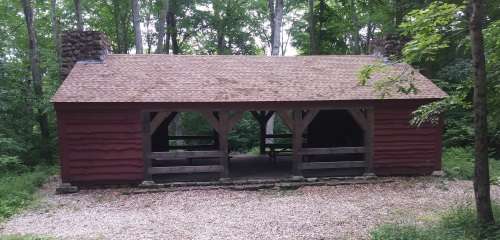
The Civilian Conservation Corps built many park shelters, like this one at Arcadia State Park in Rhode Island.
Connecticut
Connecticut had a total of 17 camps, and over 30,000 men served in the CCC. Some hadn’t enlisted, but were LEMs – locally enlisted men, such as carpenters and stone masons. Along with their traditional work, the CCC also built nine lookout towers, constructed 123 bridges and developed over 1000 acres of public camping and picnic grounds.
As in all other camps, the Connecticut CCC couldn’t build roads. They did, however, build many truck roads for fighting forest fires.
When a dam broke above Hartford in 1936, it devastated the area. The CCC lent a hand by clearing out 2,950 buildings and 800 other structures.
A CCC Museum in Stafford Springs, Conn., once the administration building for Camp Conner, contains photos, displays, information and artifacts.
Maine
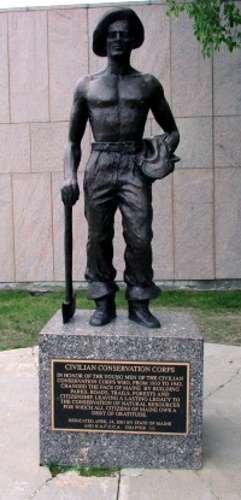
CCC statue in Augusta
Fort Williams in Portland Harbor administered and trained Civilian Conservation Corpsmen for both Maine and New Hampshire. At its height, Maine had 16,686 men, 1,612 supervisors and 1,136 out-of-state enrollees in 19 camps. Additionally, Rhode Island sent 144 to the Rangeley area. The camps closed by 1942, but in their heyday the CCC’s emphasis evolved from emergency relief to job training. The Maine and New Hampshire Tree Army sent home an estimated $4 million.
Their assigned work came from the Maine Forest Service, the U.S. Forest Service, the U.S. Bureau of Biological Survey and the National Park Service. It included, much like all the other CCC work roads, trails, recreation areas, erecting buildings, and pest control.
George Dorr, superintendent of Acadia National Park, saw his chance to improve the park in the Civilian Conservation Corps. He asked Roosevelt for a camp at Acadia. Eventually some 3,000 poor boys, mostly from Maine, came to three CCC camps in Acadia. They opened new trails and improved old ones, planted thousands of trees, made fire roads, fought fires, built footbridges and constructed two campgrounds, Blackwoods and Seawall. They built Ocean Drive, which loops around the park with stunning views of the coast and opened hiking trails to Echo Lake, Long Pond and Beech Cliff.
There is a memorial dedicated to the CCC and their work in Maine in Augusta.
Vermont
Vermont was originally allocated four camps but got 30, more than any other state of its size. The reason? The highly motivated State Forester Perry Merrill, a man with great foresight who saw the potential for CCC work.
Some 40,000 men served in the Civilian Conservation Corps in Vermont. However, only about 11,000 came from Vermont. The other companies transferred from other states such as Rhode Island because Merrill found so much work for them to do.
A massive flood in 1927 had devastated much of the state, and the Vermont CCC boys gained recognition for their flood control activities and dam building. The Civilian Conservation Corps built the 2,000-foot Waterbury Dam along with the Wrightsville and East Barre dams.
They also built many ski slopes, including the Stowe Ski Resort and the Mount Mansfield State Park. They also built 105 miles of truck roads for forest fire fighting and 10 lookout towers.
About the author of this story: Leo Caisse of East Providence, R.I., published the book, The Civilian Conservation Corps: A Guide to Their Works in Rhode Island. He has also published a number of historical articles, including Ears On the World in America in World War II Magazine, October, 2017. He earned a B.A. and M.A. in American History from Providence College. Leo passed away in 2020, and we miss him very much. This story updated in 2022.
Photos, except for the Civilian Conservation Corps pillow and statue, courtesy Leo Caisse. CCC statue by By DrStew82 – Own work, CC BY-SA 4.0, https://commons.wikimedia.org/w/index.php?curid=59856211. This story was updated in 2021.

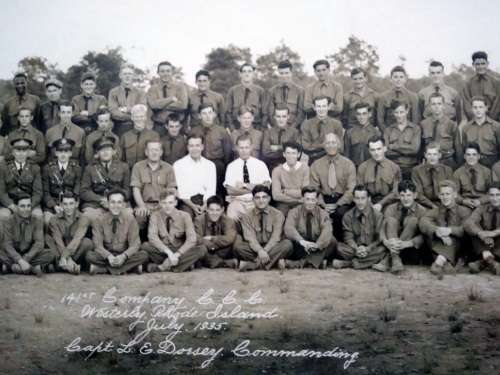
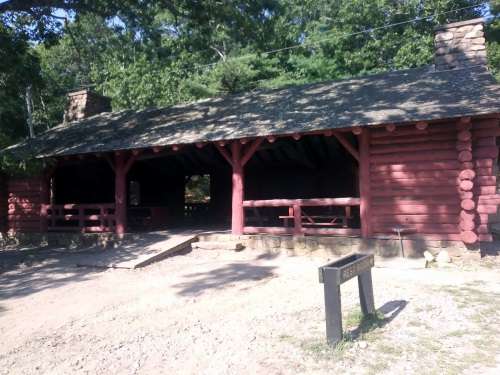
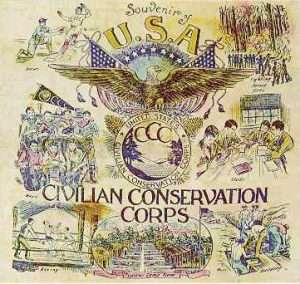

7 comments
What a great story !!!
A remarkable story indeed, so well researched and thorough and altogether enjoyable. The group photo is especially compelling with some added twists. After a closer look at the group photo I was heartened to realize that my own father was seated directly to the right author’s father, Leo Caisse. Considering that these men sat together might explain a budding friendship that would, in the years to come lead to the introduction of Leo’s sister, Rosetta to my Dad, John McGovern who would eventually marry her 10 years later in 1944. So not only is author’s father featured in the group photo, so too is his Uncle John.
[email protected]
Knoxville, MD
A remarkable story indeed, so well researched and thorough and altogether enjoyable. The 1934 group photo is especially compelling offers some added twists. After a closer look at the group photo I was heartened to realize that my own father was seated directly to the right author’s father, Leo Caisse. Considering that these men sat together might explain a budding friendship that would, in the years to come lead to the introduction of Leo’s sister, Rosetta to my Dad, John McGovern who would eventually marry her 10 years later in 1944. So not only is author’s father featured in the group photo, so too is his Uncle John.
[…] put thousands of young men to work planting and saving trees as part of his New Deal. Later the Civilian Conservation Corps took part in the fight against Dutch elm […]
[…] He was born in Worcester, Mass., on June 9, 1896, to Jewish immigrants. His father, Harris Lubin, for many years a peddler, operated a clothing store. In 1930, the business was nearly pulled under by the Depression. […]
[…] seven daughters. Jennie’s older brothers got work through the Works Progress Administration, the Civilian Conservation Corps and the garment […]
[…] Brown Company eyed a closed Civilian Conservation Corps camp in Stark as a place to house prison laborers. The camp was hastily renovated for the German […]
Comments are closed.